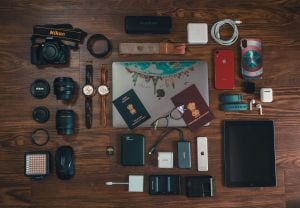If you love travelling, you know how important it is to keep your phone and gadgets charged. But did you know not all power banks are allowed on flights? In this article, you’ll learn what makes a power bank airline approved power bank and how to pick the right one for your next trip. Let’s keep your devices powered up without any airport hassle!


Editor
Mae An NG chevron_right
Table of Contents
What Does “Airline Approved” Mean?
An airline-approved power bank is a portable battery that follows safety rules set by airlines. These rules are based on how powerful your power bank is measured in watt-hours (Wh), and whether the battery type is safe for air travel.
If your power bank follows the rules, you can bring it in your hand-carry luggage, but not in check-in bags.
Quick Tip: Most airlines (including AirAsia, Malaysia Airlines, and even Singapore Airlines) follow the same basic battery rules.
Why is this important?
With more of us travelling again this year (especially during mid-year sale season and school holidays), we’re seeing an increase in tech-heavy travel. Everyone brings at least a phone, smartwatch, maybe a tablet, and all those need power banks.
But airport security is stricter now. Recently, airports like Changi and KLIA have started scanning hand luggage more carefully for power banks that exceed the 100Wh limit.
Some travellers even had their power banks confiscated on the spot. Imagine losing your expensive 20,000mAh bank just because it wasn't airline-approved.
Key Rules for Airline Approved Power Banks
1. Capacity Limit (Watt-Hours or Wh)
The most important rule is the power bank’s capacity, measured in watt-hours (Wh). Most airlines allow power banks up to 100Wh without approval. If your power bank is between 100Wh and 160Wh, you need airline approval before flying. Anything above 160Wh is usually not allowed.
2. Carry-On Only
You must carry your power bank in your hand luggage. Airlines do not allow power banks in checked baggage because of fire risks.
3. Quantity Limits
For power banks under 100Wh, you can usually bring many, but check with your airline just in case. For power banks between 100Wh and 160Wh, you can only bring up to two with approval.
How to know if a power bank is airline approved
Here’s the good news: You don’t need to do complex math.
Airline Rules in Simple English:
- Power banks below 100Wh are allowed in hand-carry
- Power banks between 100Wh – 160Wh are allowed with airline approval (some airlines may ask)
- Power banks above 160Wh are not allowed at all.
Most common power banks (like 10,000mAh or 20,000mAh ones) are usually under 100Wh — but not all! It depends on the voltage.
Easy Formula to Calculate Wh:
Wh = mAh × V ÷ 1000
Example:
- A 10,000mAh, 3.7V power bank → 10,000 × 3.7 ÷ 1000 = 37Wh
- A 30,000mAh, 3.7V → 30,000 × 3.7 ÷ 1000 = 111Wh Airline may reject it!
If the watt-hour rating is printed on the power bank, that’s even better. Just check the label. If it's not printed, that’s a red flag — airport staff may reject it.
Airline Approved Power Bank – What to Look For
When buying a travel-friendly power bank, look out for these features:
Capacity: Stay under 27,000mAh
- Power banks up to 26,800mAh (usually under 100Wh) are generally safe.
- Anything above that? Be careful — check the voltage and watt-hours.
Label: Must show mAh and voltage
- Your power bank should print the battery capacity and voltage.
- If not printed, customs might not let it pass.
Safe tech: Li-ion or Li-poly
- Most brands use lithium-ion or lithium-polymer batteries.
- As long as it’s certified and not a cheap pasar malam brand, you’re okay.
Can you use power banks on the plane?
Short answer: Yes, but with some rules.
You can use your power bank during the flight to charge phones or tablets.
You can’t use it during take-off or landing (same as laptops and tablets).
Don’t leave it charging unattended, especially overnight on long-haul flights.
Other Rules You Should Know
Here are a few more things to keep in mind:
- Airlines usually allow up to two power banks per passenger.
- Make sure your power bank has clear labels showing its capacity.
- Some airlines may not allow damaged or unknown-brand power banks.
- Check the airline's website before flying, just to be sure every airline has slightly different rules.
Where to put your power bank during travel?
This may sound basic, but many travellers make this mistake:
- Put it in your hand-carry (backpack, tote bag, cabin luggage).
- Don’t put it in your checked-in luggage; it can be a fire hazard.
- Keep it easy to access during security screening, especially when they ask you to take it out.
Why Only in Hand Luggage?
You must keep your power bank in your carry-on bag because lithium batteries can overheat. If there’s a fire, the crew can handle it faster inside the cabin. Never put a power bank in checked luggage; this is an important safety rule
What happens if you bring a Non-Airline-Approved power bank?
Airport staff may do any of the following:
- Confiscate it on the spot, especially if it's over 160Wh.
- Ask for documentation, which most of us won’t have.
- Ask you to throw it away or return it to check-in, which means wasted money and time.
Extra Tips for Power Bank Travellers
- Bring a short charging cable
Makes it neater when you use your power bank on the plane or bus. - Use a wireless charging power bank
If you have an iPhone with MagSafe, wireless charging power banks make travel even easier — no tangled wires! - Charge your power bank before your trip
Some planes don’t have USB ports. And some airports charge you RM10 just to plug in. - Buy from trusted brands
Avoid “no-name” brands with no labels or fake certifications. Stick with Anker, UGREEN, Xiaomi, Baseus, or PINENG, which are common and reliable here in Malaysia.
Final Thoughts

For Malaysians who love to travel, having an airline-approved power bank is a must. It keeps your gadgets alive without risking delays or being stopped at the airport. Remember to check the capacity, carry it in your hand luggage, and follow your airline’s rules. Now, you can fly worry-free and stay powered up wherever you go!
Stay charged, stay safe, and happy travels!
